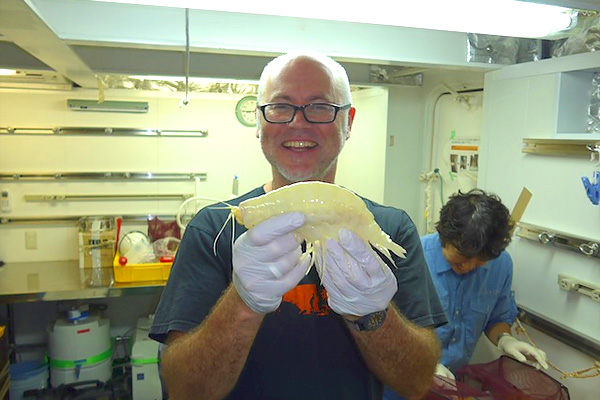QUELLEレポート
In the Realm of the Amphipod
Amphipodの帝国
2013/10/15
Ashley Rowden(National Institute of Water & Atmospheric Research)
(今回は海溝の生態系を研究しているニュージーランドのAshley Rowden博士に、深海にいる
When you turn over seaweed on the beach, or look at the remains of your bait in a crab trap - you may have seen amphipods. These shrimp-like creatures scavenge on decaying matter, and you will probably know these small crawling beasts as sand-hoppers or sea-lice. Amphipods, the scientific name means ‘different legs’, are a type of crustacean that can be found not only on beaches and in coastal bays but also in the soil of gardens, in rivers and lakes - and the deepest parts of the world’s oceans.
Where the sea is deeper than 6000 m, and the seafloor made of steep V-shaped trenches that can descend to nearly 11 km beneath the ocean surface - is true realm of the amphipod. And here amphipods can be much bigger than the centimetre or less that they typically grow to - they can be giants, or even supergiants of more than 30 cm. Imagine that, an amphipod that you can hold on the palm of your hand rather than between your fingertips.
I’m here on the RV Yokosuka to study deep-sea amphipods, to find out which species live where and why, and how closely related populations of the same species are to one another when they occur in different trenches. The ship is above the Tonga Trench, and below the hull is the second deepest place on the planet, the Horizon Deep. Here we hope to find out how the deep-sea ecosystem functions - and we won’t manage to solve that puzzle without looking at amphipods. And to do that we have to catch them - in traps or see their behaviour on video.
The traps and video camera are attached to ‘landers’ - metal frames taller than a person - that are released from the ship to free-fall to the seafloor. As well as catching amphipods the landers have a range of instruments and corers attached to them to gather other data about the trench environment. After the landers have been on the seabed for many hours, and the amphipods have swum into the traps attracted by a bait of smelly and oily fish remains, they rise to the surface again. To lift them off the bottom an acoustic signal is sent from the ship to trigger the release of ballast weights, and the floats above the lander have enough buoyancy to bring it back into the sunlight.
Once the crew of the Yokosuka have brought the lander safely back on board, we scientists busy ourselves unloading our instruments and samples - including the amphipods in the traps. It is always exciting to see what has been caught - are there many? perhaps a new species? On the return of the first lander deployment at 6200m on the edge of the trench, lying at the bottom of one of the traps was a supergiant amphipod - a specimen of Alicella gigantea. This animal was 24cm long and was the first to be sampled from the Tonga Trench. That’s exciting. There are not many records of this species, so it is interesting to find another here - and provides further evidence that this species, like a few other trench amphipod species, are capable of living in similar environments right across the globe.
While supergiants are impressive and excite the imagination, it is the identity and distribution of the smaller species that will tell us more about the ecology of trenches. So it is to the rest of the trap catches that I must pay more attention. All those other amphipods caught in the traps will need to be identified to their species name - and counted, and there can be hundreds of a particular species in one trap. Food in the form of a rotten fish carcass doesn’t often arrive at the bottom of the trench and so it attracts the many amphipods that can detect its ‘smell’ as it is carried in the water currents that sweep the seafloor. These pulses of food are important to amphipods of the trenches, just like the piles of seaweed that get washed up after a storm are to the sand-hoppers on the beach, and they have adapted to be able to detect them soon after they arrive from the waters above.
When all the amphipod species have been identified and counted from the different sites that we have sampled in the trench during this scientific voyage, this information can be analysed along with similar data from other trenches - to help reveal the answers to many questions. Do different amphipod species prefer to live where there is particular types or amounts of food, what proportion of these food types do different species consume, can they or can they not compete with other amphipod species for this food, are they fed upon by other amphipods or other creatures, do they only occur at particular temperatures, and have they evolved to live in one trench or have they dispersed and occur in more than one trench?
Help to answer these questions about amphipods will come from the data gathered by other scientists on this and other voyages that are trying to understand the relationships between the different parts of the deep-sea ecosystem, and trenches in particular. But looking at all the white shrimp-like organisms darting across the video taken at the floor of the Tonga Trench - you get the sense that here we are in the realm of the amphipod.
浜辺で海藻を裏返したり、カニカゴに残った餌を見ると
深度6000m以上で、表層から11km近い深さにもなるV字型の海溝は、まさに端脚類の帝国です。ここでは、端脚類は1cm以上の大きさになり、あるいは巨大化し、なかには30cm以上の超巨大になるものもいます。端脚類を二本の指先でつまむではなく、手のひらに載せるところを想像してみてください。
私は深海性端脚類の研究のために「よこすか」に乗船し、どの種類がどのような理由でどこに住んでいて、異なる海溝に住む同じ種類の端脚類の集団がどの程度交流があるかを知りたいと思っています。トンガ海溝の上に研究船「よこすか」がおり、船の下には世界で2番目に深いホライゾン海淵があります。私たち研究者は深海生態系の機能がどのようなものなのかを理解したいのですが、その難問は端脚類を知らないと解けないと考えています。そのためにトラップを仕掛けて捕まえたり、深海カメラで行動観察を行う必要があるのです。
トラップとビデオカメラは人の背よりも高い金属製のフレームを持つ「ランダー」にとりつけました。「ランダー」は海底に向けて自由落下式に投入します。「ランダー」には、端脚類を捕獲するだけでなく、海溝の環境を知るための採泥器や環境計測機器を取り付けています。「ランダー」が着底してから数時間で、餌のくっさーい、あぶらっぽい切り身の匂いなどにつられて端脚類がトラップに入った頃、「ランダー」は海底を離れ、海の表層にあがってきます。海底から海面に上昇するために、「ランダー」は、「よこすか」から音響信号を受信してバラスト(錘)を切り離し、浮き上がってくるのです。

写真1:「ランダー」にトラップを仕掛けるRowden博士
Dr. Rowden set up a trap to "Lander"
「よこすか」の乗組員が「ランダー」を安全に船に揚収すると、私たち研究者は、トラップにかかった端脚類を含めて、サンプルや観測測器を取り外したりするために忙しくなります。どのくらいいるのだろうか?もしかしたら新種かも?と、毎回、何が捕まっているのかわくわくしながら調べています。海溝外側斜面の水深6200m地点で、最初の「ランダー」調査を行なったとき、トラップの1つに超巨大ヨコエビ、Alicella gigantea(アリケラ・ギガンテア)がいました。採集したものは24cmの長さで、トンガ海溝からの最初の標本です。これにはとても盛り上がりました。この種はこれまでにあまり記録がないので、ここで見つかったこと自体興味深いのですが、それと同時に、ほかの2〜3種類の海溝にいる端脚類のように、この種が地球上の似たような超深海環境に住むことができる、さらなる状況証拠も提供してくれています。

写真2:超巨大ヨコエビを持って満面の笑みのRowden博士(写真提供:道林克禎)
Dr. Rowden has a big smile with supergiant amphipod (photo by Katsuyoshi Michibayashi)
もちろんこの超巨大ヨコエビは印象的で、想像力をかき立てるのですが、一方で、1cm〜数cm程度の小さな端脚類も大事で、その特性や分布が海溝生態系についてさらに物語ってくれます。だから超巨大ヨコエビ以外のトラップに捕まえられたものについても、見逃さないように気を使っています。トラップにかかった他のすべての端脚類についても、種を同定し、また個体数を数えます。1つのトラップに百匹以上の端脚類がいることがあります。海溝では腐った魚の死骸などめったに落ちてこないので、海底に漂う匂いにつられてたくさんの端脚類が集まってくるのです。浜辺にいるハマトビムシが、嵐の後、打ち上がった大量の海藻にすぐ群がるように、このような稀に落ちてくるエサは海溝にいる端脚類にとって大事なのです。
この航海を通じて、私たちは海溝内の異なった場所で採集した端脚類すべてを同定し、数えます。この情報を他の海溝から得たデータと比較し検討することで、以下のような、多くの疑問に答えることができるようになると考えています。たとえば、異なる種類の端脚類は、特定の餌、餌の量によって住む場所が違うのか?それぞれの端脚類はどのくらいの割合でそれぞれの種類の餌を消費するのか?餌を巡った端脚類同士の競争はあるのか?他の端脚類あるいは他の生物に食べられるのか?特定の温度の時にしか活動しないのか?1つの海溝に住み続け、そこで進化するのか?あるいは複数の海溝に分散して分布しているのか?などの疑問です。
この航海で他の研究者たちが集めたデータや、特に海溝生態系の関係性について理解しようとしているほかの航海のデータは、端脚類についてのこれらの疑問を解き明かす助けになります。とにかく、トンガ海溝の海底で撮影されたこの白いエビのような生き物が泳ぎまわっている映像を見てもらえれば、「私たちは端脚類の帝国にいるのだ」ということを、あなたにもわかってもらえると思います。
" we are in the realm of the amphipod "